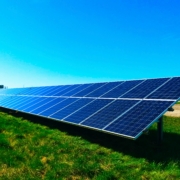Tools for Building a Brighter and Greener Future
By Dan Salas and Ben Campbell, University of Illinois Chicago Sustainable Landscapes Program
Building out the renewable energy capacity needed to make a clean energy transition is no easy task. Siting projects, engineering designs, addressing community interests, and obtaining the resources for construction requires thoughtful planning. Increasingly, one design aspect is gaining more attention: plants.
As important as any solar panel array, substation, or other “hard” infrastructure, the plants making up the ground covers are critical to site management. Vegetation on renewable energy development (particularly community- and utility-scale solar) has gained attention for its ability to provide added benefits like pollinator and wildlife habitat, soil health, runoff reduction, carbon capturing, and community aesthetics.
Plant communities, just like other design components, are influenced by many factors. Often underestimated as “the green stuff,” designing, installing, establishing, and maintaining plant communities on large solar arrays can be costly and complex. When done well, it can create an asset to both the project and community. When implemented poorly, it can become a costly and long-term headache for site owners and communities.
Across the country, communities are asking that solar projects include pollinator habitat in their vegetation planning. As a result, solar developers and site owners have had to face questions like:
- What types of plants are included in solar pollinator vegetation?
- How do I establish it?
- How much will this cost?
- If successful, will it result in improvements for local pollinators?
- How do we sustain vegetation investments over the duration of solar project lifespan?
To address these questions, in 2021, The University of Illinois Chicago, U.S. Department of Energy Solar Energy Technologies Office Awardee, began the Pollinator Habitat Aligned with Solar Energy (PHASE) project. This four-year project studies the ecological, economic, and performance impacts of solar pollinator vegetation. Building on this research and industry collaboration, the project also created a suite of decision tools to help site designers and vegetation planners with making informed decisions about plant selection, vegetation management, and addressing project and community goals.
The four tools developed under the PHASE project have been released and are now free and available for use:
- The solar pollinator vegetation implementation manual is an interactive online document to guide users through considerations for vegetation decisions at large- scale solar sites. It also helps identify site goals, pitfalls for implementation, and how to sustain desired benefits over the duration of a project lifespan.
- A cost comparison calculator was developed to help project teams consider upfront and long-term costs of plant communities designed for projects. This tool is offered in two formats: one is a simplified online calculator for quick estimates, and the other is a downloadable Excel tool that allows teams to edit more variables and create a more refined estimate. The outputs of this tool can help inform decisions on construction and operational budgets.
- Once target vegetation communities have been identified and budgeted for, the seed selection tool can be used to find species suitable for seed-mixed development. Users can then connect with seed vendors and share outputs to purchase seed material. Project design teams may also use this tool to confirm seed mixes identified for a site and potential substitution species, if needed. Outputs of this tool can be shared with project teams and seed vendors to help seed-mix development in site, design, and vegetation management planning.
- Once vegetation is established, the pollinator habitat assessment modules can help verify that vegetation was successfully established and the desired pollinator benefits have resulted from the work completed. A three-tiered series of assessments offers scalability, depending on time and knowledge resources available. These rapid assessments are supplemented by a series of guidance documents that help users decide sampling regimes monitoring needs and reduce monitoring costs.
Together, these tools offer the renewable energy industry a series of resources that will help improve vegetation management across thousands of acres. While developed with solar pollinator vegetation in mind, these tools are also applicable to other vegetation management programs. Better vegetation management and planning combined with renewable energy creates a brighter future for humans and nature alike.
About the Solar Energy Technologies Office
The U.S. Department of Energy Solar Energy Technologies Office accelerates the advancement and deployment of solar technology in support of an equitable transition to a decarbonized economy. Learn more at energy.gov/eere/solar.
About the University of Illinois Chicago Sustainable Landscapes Program
The University of Illinois Chicago (UIC) Energy Resources Center is home to the Sustainable Landscapes Program and the Rights-of-Way as Habitat Working Group, which convenes people at the intersection of biodiversity and infrastructure.



